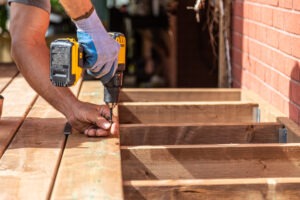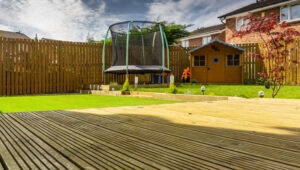- Home
- About Us
- Member Profiles
- Help and Advice
arrow_drop_down
- Conciliation
arrow_drop_down
- Guild magazine
How to lay decking
If you’re looking to create a separate entertainment space in your garden, either for soaking in a hot tub, lounging on deckchairs or hosting dinner parties, then wood decking is a great option. You might even be feeling brave enough to have a go at installing the garden decking in the outdoor space yourself. If so, the following DIY guide to laying decking will come in handy.
What tools and materials will I need to build a deck?
The essential materials you’ll need to lay decking include the following:
Your decking boards
 A carpenter’s square
A carpenter’s square
Decking screws
Joists
Nail gun
Framing hammer
Handsaw
Circular saw
Tape measure
Spirit level
Concrete blocks
Chalk or builder’s line
Power drill
Last but not least, a pencil
What preparation do I need to do before laying garden decking?
- First of all, you need to clear any debris from the outdoor space where the decking will be located. Some factors to consider when choosing an outdoor space for your decking are: does it get enough sun? Does it have a nice view? Is there enough privacy? Is the ground dry underfoot, because wet or boggy ground will cause problems?
- Measure out the area where your decking is going using your carpenters square and measuring tape. Mark the outline using a builder’s line or a piece of chalk.
- Measure your joists and decking boards. Use a saw to cut your decking boards to the correct length for the size of your planned decking. Be sure to use protective clothing like a face mask and goggles when cutting the wood.
Top tip: You should use a weed membrane to treat your decking boards before laying them. Otherwise, weeds could end up seriously spoiling your garden decking.
 How do I construct the sub-frame for my garden decking?
How do I construct the sub-frame for my garden decking?
- Place your concrete blocks on the site marked out for your decking. These will support the decking boards. You need to ensure that there’s a concrete slab at each corner of the decking.
- Assemble the joists into the shape of your new wood decking and lay this frame over the chosen decking area. Use your spirit level to check that it’s even.
How do I lay the decking?
Patience is definitely a virtue when it comes to installing decking. Proceed slowly, repeatedly checking that your work is level and stable so that it will last you for years.
- Lay your decking boards, starting from a corner of the lower frame. Each of the boards should be placed in the opposite direction to the sub-frame joists.
- Use your power drill to make 7cm holes in your boards. Attach your decking boards to the joists using decking screws. You should leave small gaps of 5-8mm between your boards to allow for rain runoff and for expansion or contraction throughout the decking boards’ life.
- Proceed one row of wood decking boards at a time, checking that all the joists and boards are firmly attached.
Can you lay decking on uneven ground?
Answer: yes, it’s possible, although it requires more groundwork and makes for a more challenging, riskier project. How you handle it depends on the kind of ground you’re dealing with; if it’s sloping, you can use support posts to keep your decking level, while if it’s uneven you can create a level base to correct it.
If you’re installing support posts, you’ll need to begin by digging a hole for each post that’s about 1 foot deep. Cut your posts to the right height for your wood decking and fix them in the holes using concrete mix. Fix joists to those poles that form the outer sides of the decking and then lay the boards as previously described.
If you plan on creating a level base, dig down about 20cm into the area that you’ve marked out for your decking. Build your decking sub-frame and use stone paving slabs placed along the middle and edges of the frame to create a balanced, sturdy surface for your decking boards.
 Can you lay decking on concrete flooring?
Can you lay decking on concrete flooring?
Yes, you can.
- If the concrete slabs are uneven or filled with cracks, you’ll need to use some self-levelling compound to create a flat surface for your decking.
- Cut some sleepers to the correct size and lay them out over the concrete flooring. Use spacers to build a level support for the wood decking. Now you can screw them in with your power drill.
- Place your decking boards on the sleepers and screw them in to fix them in position.
Can you lay decking on grass or soil?
Yes, but it’s not advisable. Grass and soil are risky because of their softness and instability. Extensive preparation is required to ensure that installing decking on grass or soil won’t cause you problems later.
On grass, you need to clear the area where you plan on putting the decking of any weeds or rocks. Dig out the ground to roughly 5cm, using a spirit level to check it’s even. Put down a weed-proof membrane to protect your wood decking from weeds and fill it with gravel to serve as a solid base. Now you can build your decking on top.
Soil is pretty much the same process. If your soil isn’t very compact and firm, you might want to consider using hardcore too, so that your decking has a surer base.
Whether you’re laying decking on grass or soil, you might want to use concrete paving slabs to create a level and more durable foundation for your decking.
More top tips for laying decking
If you want to save time and make it easier for yourself, you should consider using composite decking instead of wood. Composite decking is longer lasting and, unlike wood decking, it doesn’t need treatments like painting or staining before it’s ready for use. Another time-saving alternative is decking tiles, which clip together, speeding up the process and ensuring that all the tiles fit smoothly and seamlessly.
For safety, you might want to add a handrail to your new decking. You could attach your handrail to some support posts using more decking screws.
You can find more advice on laying decking here: https://www.wickes.co.uk/how-to-guides/garden-landscaping/plan-lay-a-deck

